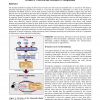Free Online Productivity Tools
i2Speak
i2Symbol
i2OCR
iTex2Img
iWeb2Print
iWeb2Shot
i2Type
iPdf2Split
iPdf2Merge
i2Bopomofo
i2Arabic
i2Style
i2Image
i2PDF
iLatex2Rtf
Sci2ools
JASIS
1998
1998
Speech Recognition for a Digital Video Library
The standard method for making the full content of audio and video material searchable and is to annotate it with humangenerated meta-data that describes the content in a way that the search can understand, as is done in the creation of multimedia CD-ROMs. However, for the huge amounts of data that could usefully be included in digital video and audio libraries, the cost of producing this meta-data is prohibitive. In the Informedia Digital Video Library, the production of the meta-data supporting the library interface is automated using techniques derived from artificial intelligence (AI) research. By applying speech recognition together with natural language processing, information retrieval and image analysis, an interface has been produced that helps users locate the information they want and navigate or browse the digital video library more effectively. Specific interface components include automatic titles, filmstrips, video skims, word location marking and representative frames ...
| Added | 22 Dec 2010 |
| Updated | 22 Dec 2010 |
| Type | Journal |
| Year | 1998 |
| Where | JASIS |
| Authors | Michael J. Witbrock, Alexander G. Hauptmann |
Comments (0)

